Despite all the scientific knowledge and criticism out there, Hollywood still can’t shake its bad habit of making movie physics mistakes.
While watching a space movie, I often find myself sitting there, shaking my head, thinking,
Come on! You had a $450 million budget, and you couldn’t hire a physicist for a quick consult?!
Now, I get it. Too much realism can be a buzzkill for mainstream blockbusters. But that won’t stop me from dishing on my top 5 space movie physics mistakes.
#1 Explosions in space
This is hands-down the most common movie physics goof.
You see it all the time: a spacecraft blows up, complete with deafening noise and big, fiery explosions. Meanwhile, the victorious spacecraft nearby seems unscathed. The camera then cuts to the smirking captain, relishing the victory without a worry in the world.
Reality check: space explosions are a whole different beast. Let’s take a quick crash course in sound and light to see why.
What is sound?
Sound is a mechanical wave that transfers energy from one point to another through a medium. This medium can be liquid, solid, or gas.
As a result, the speed of sound depends on the medium it’s traveling through. On Earth, at sea level and a 59-degree Fahrenheit air temperature, sound zips along at 761 miles per hour.

Important Note: In space, you can’t hear a thing. Sound waves need a medium to transfer energy, but space is a vacuum, devoid of a medium. So, there’s no “boom, bam, pow” coming from explosions or gunfire in space.
What is light?
Light is an electromagnetic wave that, unlike sound, doesn’t require a medium to travel. Light travels at an impressive 186,000 miles per second.
Back to our space explosion talk
When a spacecraft explodes, it would turn into a massive expanding cloud of gas. This gas would then hurtle at supersonic speeds, crashing into any nearby spacecraft. The occupants inside would hear a loud thud, as if they’d just hit a wall.
Newsflash: being a spectator to a space explosion is a terrible idea. You’re basically playing Russian roulette with your life, because the debris is no joke.
The fragments rocket out in all directions like bullets fired from a rifle. Except, they don’t slow down until they hit something. There’s no gravity to pull them down and no air drag to slow them down.
So, whether you’re 1 mile or 10,000 miles away from the blast, those deadly projectiles would maintain the same kinetic energy. And to top it all off, there’s nowhere to hide in space.

Important Note: In space, fire can’t exist unless a spacecraft carries oxygen. Fire requires oxygen to keep the combustion process going.
What filmmakers should do?
They should raise the shields of spacecraft close to explosions, protecting against debris. Without shields, nearby spacecraft would be damaged beyond repair. And, for crying out loud, please eliminate all sound in space.
#2 Space traveler’s helmets
Picture this: after years of searching, our space explorers finally stumble upon an Earth-like planet. They’re over the moon (pun intended) and can’t contain their excitement. They land their spacecraft and immediately whip off their helmets.
Lo and behold, this planet is like a doppelgänger of Earth, complete with oxygen and an Earth-like atmosphere. But hold up! Not so fast. Here are a few reasons why you’d want to keep that helmet locked in place:
- Oxygen: Too much of a good thing can be deadly, and oxygen is no exception.
- Other gases: Who knows what lethal, breathable gases could be lurking around?
- Microbes: If the planet supports life, there might be dangerous alien microbes floating about, invisible to the naked eye.
What filmmakers should do?
Keep those space helmets on!
Don’t let characters just yank off their helmets as soon as they touch down on an uncharted planet. An in-depth atmospheric analysis is always required first.
#3 Lasers fired in space

You know those epic Star Wars battles featuring the X-wing fighters we all adore?
Lasers are constantly zapping at X-wings, and the pilots perform some slick moves to dodge them and return fire. It’s exhilarating to watch, but not exactly realistic. Those red laser beams flying everywhere just wouldn’t be visible in space.

Laser: A laser is a concentrated wavelength of light produced by a device, which emits a powerful and controlled stream of light, or beam.
If you’ve ever played with a laser pointer, you know the red dot is only visible when it hits a target. That’s because the light scatters off the material, making the dot visible.
In most cases, you can’t see the red beam itself. It only becomes visible when the light collides with particles in the air, scattering and reflecting the light in different directions. Some of this light then scatters towards your eyes, making the beam visible.
Three factors make lasers visible:
- Frequency of the laser: The laser beam needs to have a wavelength our eyes can see.
- Intensity of the laser: High-powered lasers emit loads of photons, increasing the likelihood of interacting with air particles and making the beam visible.
- Impurities in the air: Shine a laser pointer through mist, chalk dust, or smoke (especially in a dimly lit area) and the beam becomes more visible. Even in clean air, you can sometimes spot a laser beam because light scatters and reflects off air molecules.

Important Note: The same principle applies to sunbeams. What we call sunbeams are actually sunlight reflecting off small particles in the air. In a vacuum, though, you wouldn’t see sunbeams.
Now, back to space. Space is a vast vacuum, meaning there aren’t particles floating around everywhere. So, what will the photons of light collide with in space? Nada!
Those fired laser beams just wouldn’t be visible. But let’s take this discussion up a notch.
Speed of light versus laser spears
X-wing fighters shoot laser beams, and light travels at a whopping 186,000 miles per second. How could the human eye even catch a glimpse of these beams? It’s downright impossible!
On Earth, our eyes couldn’t detect these laser beams. In the best conditions, they’d appear as continuous beams stretching from the laser gun to the target.
The infinite range of weapons
You know what’s wild? Weapons in space have no range limit! On Earth, gravity eventually makes bullets or missiles drop, but out in space, they’ll just keep on going until they either collide with a massive object or fall into orbit around one.
Chances are, a weapon fired in space would just travel on forever, considering how vast the universe is. It’s like how we can see light from stars trillions of miles away. The bottom line is that a weapon launched in space shouldn’t have a set range where it just stops.
What filmmakers should do?
How about inventing some non-laser spear weapons? That’d be rad!
#4 Gravity inside spaceships

Picture this: the spacecraft doors burst open, and a frantic astronaut, who’s been flailing about in the cold vacuum of space, is yanked inside. The moment they’re in, they crash to the floor with a thud. Desperately gasping for air, the astronaut rips off their helmet as soon as the doors seal shut.
Now hold up! Where did that gravity come from all of a sudden? According to movie logic, space has no gravity or air, but when air enters the picture, gravity just magically appears. Gravity doesn’t work this way though.

Important Note: Gravity is this awesome force of nature that pulls everything with mass or energy towards each other. If you have two objects with similar mass, they won’t have much force between them. But when one object is super massive compared to the other, that’s when gravity kicks in.
Imagine us humans on Earth. We can strut our stuff because Earth’s gravitational force keeps us grounded. But deep space? That’s a whole different ball game. Objects will just float around when they’re far from other massive things.
So, let’s get back to our astronaut friend in the spacecraft. The mass of an astronaut compared to a spacecraft is nothing like the mass of an astronaut compared to Earth. So really, our astronaut should still be floating inside the spacecraft, not smacking down on the floor.
What filmmakers should do?
Keep characters floating when they enter a spacecraft. But, this creates a whole new challenge: how do you create artificial gravity inside a spacecraft?
One solution is centripetal force. Spin that bad boy around and bam, you’ve got gravity. Not the most glamorous fix, but it works.
#5 Thrusters on spacecraft
In most movies, spacecraft have thrusters blasting full throttle, engines glowing and roaring as they zoom through space. But hold on a sec—space is silent! Anyway, I digress.
To understand spacecraft thrust, let’s chat about Newton’s second law of motion. This law says an object accelerates when a force acts on a mass. In space, though, a force makes an object change speed, not maintain constant motion. It’s a bit confusing because of what we see on Earth.
On Earth, if you want to keep a box moving at a constant speed on asphalt, you got to push it with constant force. You need that force to beat friction and air drag. But guess what? Space is a vacuum! There’s no friction, so a spacecraft doesn’t need thrusters to keep going at a constant speed. Spacecraft thrusters only kick in to:
- Accelerate from a standstill
- Speed up
- Slow down
- Change direction

Important note: In the real world, spacecraft use as little fuel as possible in space. It’s super expensive to get fuel up there! They turn on their engines to hit their desired speed and then cruise along, engines off, coasting on their momentum. When they reach their destination, they fire up their engines again to slow down.
What filmmakers should do?
Switch off those spacecraft thrusters when traveling at constant speeds. Momentum will keep ’em going without losing speed. Need to stop? Just apply an equal and opposite force in the direction of travel.
To learn more about rocket engines, check out the operation of SpaceX’s Raptor engine.
Movie physics mistakes wrap up
These five movie physics mistakes show that most movies are just for kicks. Don’t get me wrong, I still love watching space flicks, especially Star Wars.
But it’d be insanely cool if, just once, a space movie nailed the physics. No bogus theories or broken science, just pure, unadulterated realism. Sure, it might not rake in the big bucks, but maybe it’d attract a whole new crowd of moviegoers. I say go for it!
Which space movie would you say is the most realistic? I personally side with “Contact, 2001: A Space Odyssey”. Also, which movie physics mistakes do you find to be the most insulting?

Author Bio: Koosha started Engineer Calcs in 2019 to help people better understand the engineering and construction industry, and to discuss various science and engineering-related topics to make people think. He has been working in the engineering and tech industry in California for well over 15 years now and is a licensed professional electrical engineer, and also has various entrepreneurial pursuits.
Koosha has an extensive background in the design and specification of electrical systems with areas of expertise including power generation, transmission, distribution, instrumentation and controls, and water distribution and pumping as well as alternative energy (wind, solar, geothermal, and storage).
Koosha is most interested in engineering innovations, the cosmos, sports, fitness, and our history and future.
